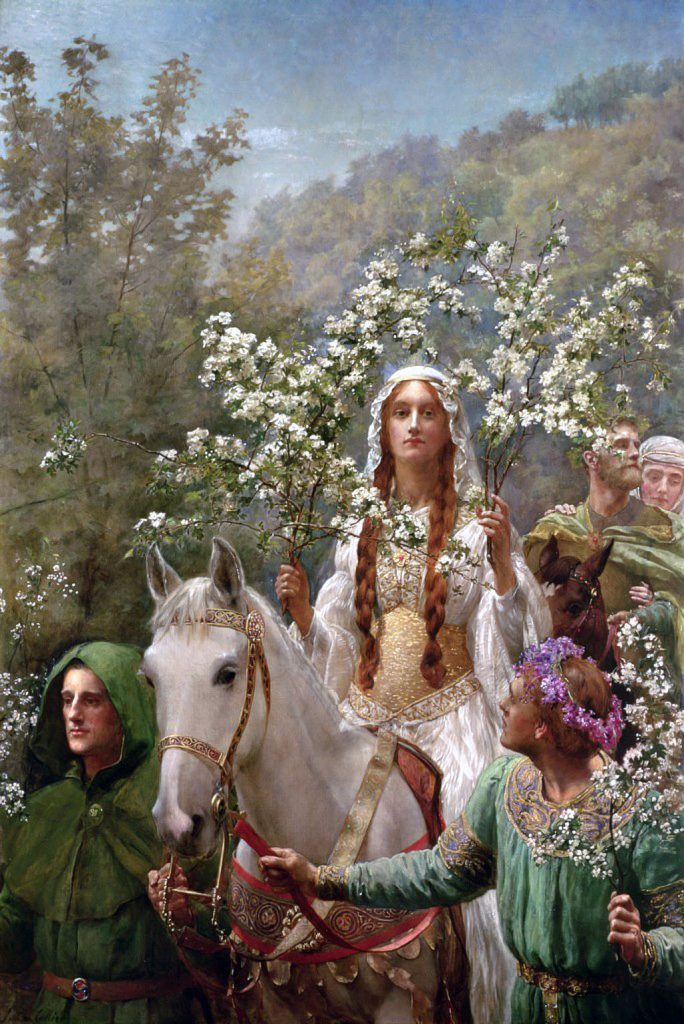

In French chivalric romances and the later works based on them, including the influential Le Morte d’Arthur by Thomas Malory, Guinevere is the daughter of King Leodegrance, who had served Arthur’s father Uther Pendragon and was entrusted with the Round Table after Pendragon’s death.
In these stories, Leodegrance’s kingdom typically lies near the Breton city of Carhaise (the modern Carhaix-Plouguer). In the fields to the south and east of Carhaise, Arthur defends Leodegrance by defeating King Rience. This leads to his meeting and marriage with Guinevere.
This version of the legend has Guinevere betrothed to Arthur early in his career, while he was garnering support. The following narrative is largely based on the Lancelot-Grail (Vulgate) prose cycle, telling the story of Lancelot and Guinevere in accordance to the courtly love conventions still popular in the early 13th-century France but soon afterwards directly condemned in the Post-Vulgate Cycle retelling that was a main source for Malory.
When the great knight Lancelot arrives from the continent, Guinevere is instantly smitten. Following his early rescue of her from Maleagant (in Le Morte d’Arthur this episode only happens much later on) and his admission into the Round Table, and with Galehaut‘s assistance, she and Lancelot begin an escalating romantic affair that in the end will lead to Arthur’s fall. In the Vulgate version, the lovers spend their first night together just as the adulterous Arthur sleeps with the beautiful Saxon princess named Camille or Gamille (an evil enchantress whom he later continues to love even after she betrays and imprisons him, though it was suggested that he was enchanted).
Arthur is also further unfaithful during the episode of the “False Guinevere” (who had Arthur drink a love potion to betray Guinevere), her own twin half-sister (born on the same day but from a different mother) whom Arthur takes as his second wife in a very unpopular bigamous move, even refusing to obey the Pope’s order for him not to do it, as Guinevere escapes to live with Lancelot in Galehaut’s kingdom.
The French prose cyclical authors thus intended to justify Guinevere and Lancelot’s adultery by blackening Arthur’s reputation and thus making it acceptable and sympathetic for their medieval courtly French audience. Malory’s Le Morte d’Arthur, however, portrays Arthur as absolutely faithful to Guinevere, even successfully resisting the forceful advances of the sorceress Annowre for her sake, except as a victim of a spell in a variant of the “False Guinevere” case.
Years later, following the Grail Quest, Malory tells his readers that the pair started behaving carelessly in public, stating that “Launcelot began to resort unto the Queene Guinevere again and forget the promise and the perfection that he made in the Quest… and so they loved together more hotter than they did beforehand.”
They indulged in “privy draughts together” and behaved in such a way that “many in the court spoke of it.” Guinevere is charged with adultery on three different occasions, including once when she is also accused of sorcery.
Their now not-so secret affair is finally exposed by Guinevere’s sworn enemy and Arthur’s half-sister, the enchantress Morgan le Fay who had schemed against her on various occasions (sometimes being foiled in that by Lancelot, who had also defended Guinevere on many other occasions and performed assorted feats in her honour), and proven by two of King Lot‘s sons, Agravain and Mordred.
Revealed as a betrayer of his king and friend, Lancelot fights and escapes. Incited to defend honour, Arthur reluctantly sentences his wife to be burned at the stake. Knowing Lancelot and his family would try to stop the execution, the king sends many of his knights to defend the pyre, though Gawain refuses to participate.
Lancelot arrives with his kinsmen and followers and rescues the queen. Gawain’s brothers Gaheris and Gareth are killed in the battle (among others, including fellow Knights of the Round Aglovale, Segwarides and Tor, and originally also Gawain’s third brother Agravain), sending Gawain into a rage so great that he pressures Arthur into a direct confrontation with Lancelot.
Back to Arthur
Guinevere later returns to Arthur from Lancelot’s castle and is forgiven (Arthur starts to doubt that Guinevere ever betrayed him). When Arthur goes after Lancelot to France, he leaves her in the care of Mordred, who plans to marry the queen himself and take Arthur’s throne.
While in some versions of the legend (like the Alliterative Morte Arthure, which removed French romantic additions) Guinevere assents to Mordred’s proposal, in the tales of Lancelot she still hides in the Tower of London, where she withstands Mordred’s siege, and later takes refuge in a nun convent (at Almesbury in Tennyson‘s more modern retelling).
Hearing of the treachery, Arthur returns to Britain and slays Mordred at Camlann, but his wounds are so severe that he is taken to the isle of Avalon by Morgan. During the civil war, Guinevere is portrayed as a scapegoat for violence without developing her perspective or motivation.
However, after Arthur’s death, Guinevere retires to a convent in penitence for her infidelity. Her contrition is sincere and permanent; Lancelot is unable to sway her to come away with him. Guinevere meets Lancelot one last time, refusing to kiss him, then returns to the convent where she spends the remainder of her life. Source: Wikipedia.







